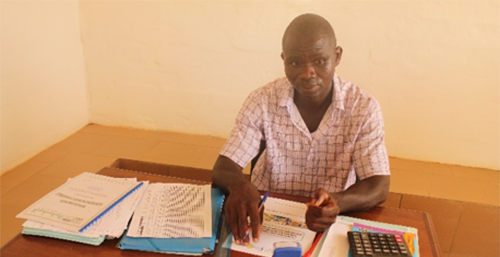
To support standardized and quality local millet, a mix of producers, processors, storage warehouse managers and other millet value chain servicers are coming together around millet “hubs” across different regions in Senegal.
Thirteen multi-service hubs are already set up across three regions of Senegal as part of the Millet Business Services Project, which NCBA CLUSA is implementing with the U.S. Department of Agriculture (USDA). The hubs work by membership, where producers pay an annual fee to access a range of services, training and inputs. The collected fees are used to create a guaranteed loan fund that supports producers through the lean season and provides access to finance when they need to buy seeds and fertilizer.
Each hub has a management committee that determines a set of rules for the membership. Democratically elected, the management committees set rates for services and transparently manage the hubs. Management teams go through training on administration, finance and governance with the project, setting them up for success and building trust with the producers.
Currently serving close to 8,500 producers, the hubs have given structure to a younger generation of farmers looking to get involved. Over half of members are younger farmers under 40.
Strategically located near regional cities to capture markets for local millet, many of the hubs funnel their sales to processing units in the capital Dakar and Touba, another large city, capturing markets typically out of reach for more isolated communities.
One of these hubs, located in Gagué Chérif, is now equipped with a millet storage warehouse capable of storing up to 500 tons, a mini pallet and pallet truck, thresher, huller and mill for hire, as well as an office space for the management committee.
The hub is successful in large part because of the dynamism of the conservation farming network in the region, a connected membership and strong producer leadership. To date, hub members number nearly 500 and can access services like plowing, threshing, financing inputs, marketing and millet storage. With the average doubling of yields from conservation agriculture techniques, producers saw a need to aggregate and take advantage of proper storage and marketing.
“The project involved us in the decision making and entrusts us with the management and realization of the activities. We are spreading training around composting and financial management across the organization,” said Sadakh Senghor, president of the Conservation Farming Network in Gagué Chérif, and chairman of the millet hub management committee.
Last year, the network broke records for the region, surpassing 50,000 tons in harvested millet, Senghor said. With the longer term storage and services from the millet hubs, they were able to invest in the financing fund and spread that investment across the year.
“In the lean period the attics used to be empty. With the construction of the hub and the increase in yields, families have enough all year round,” Senghor said.


